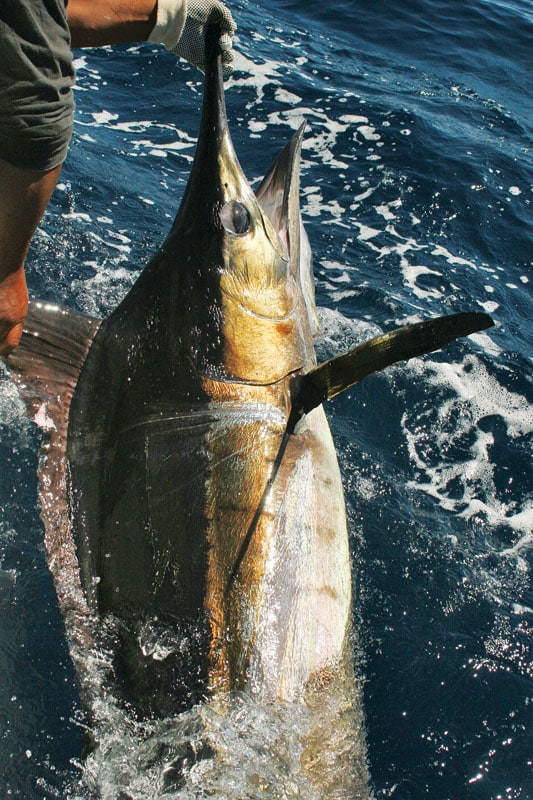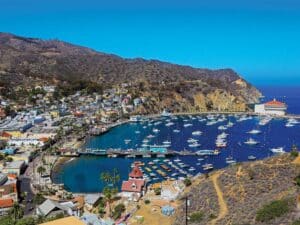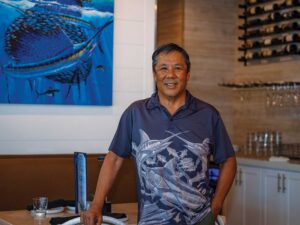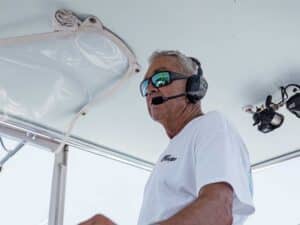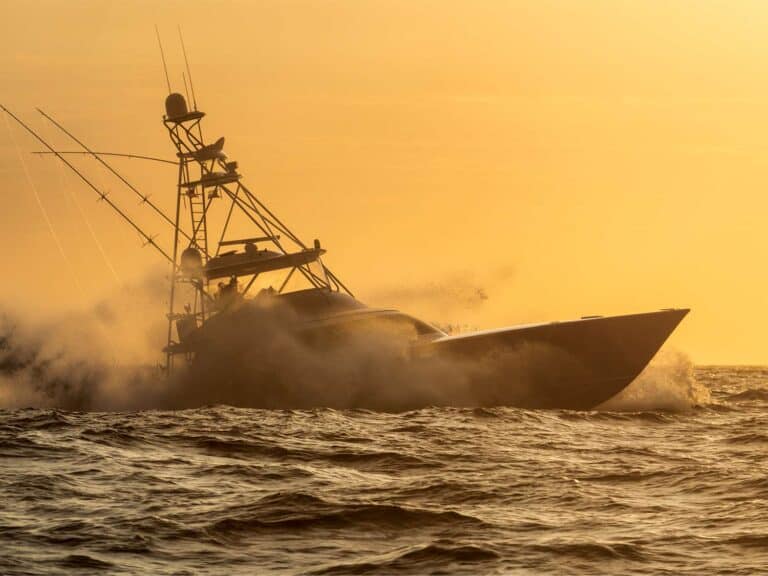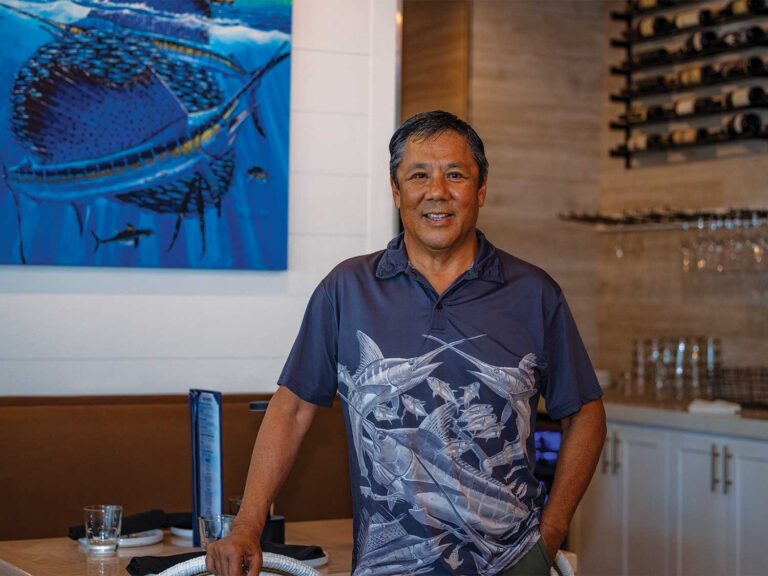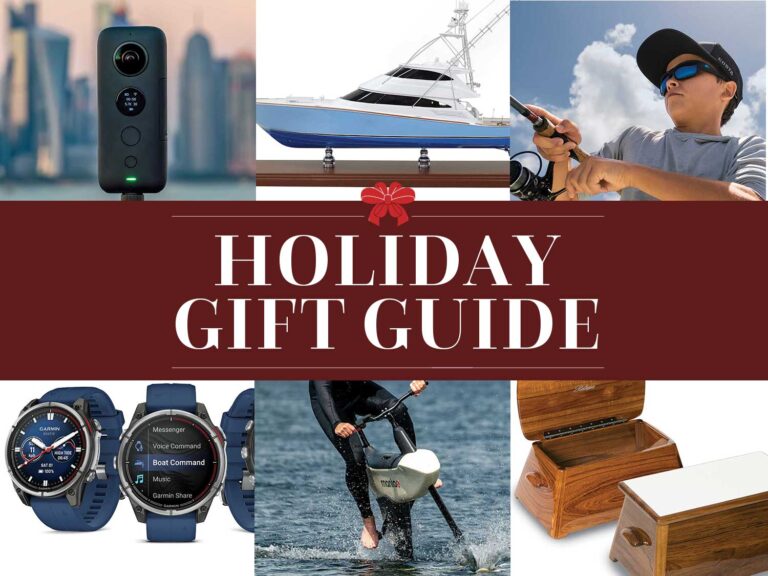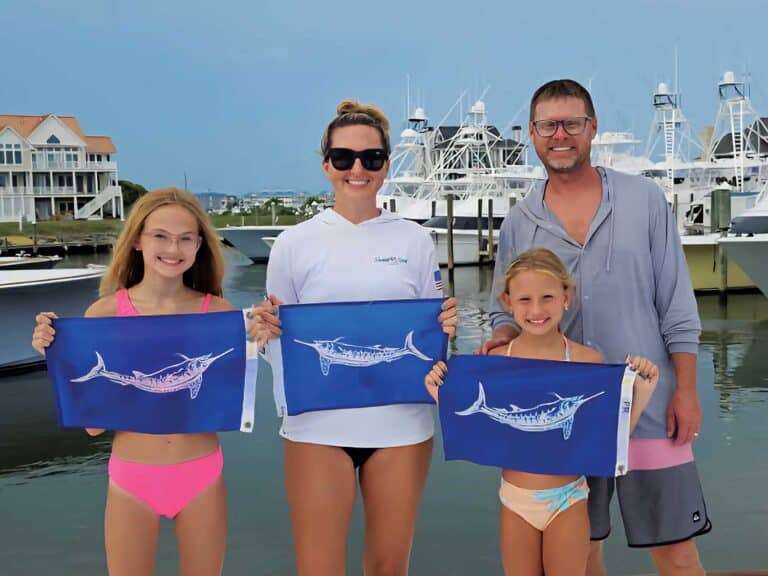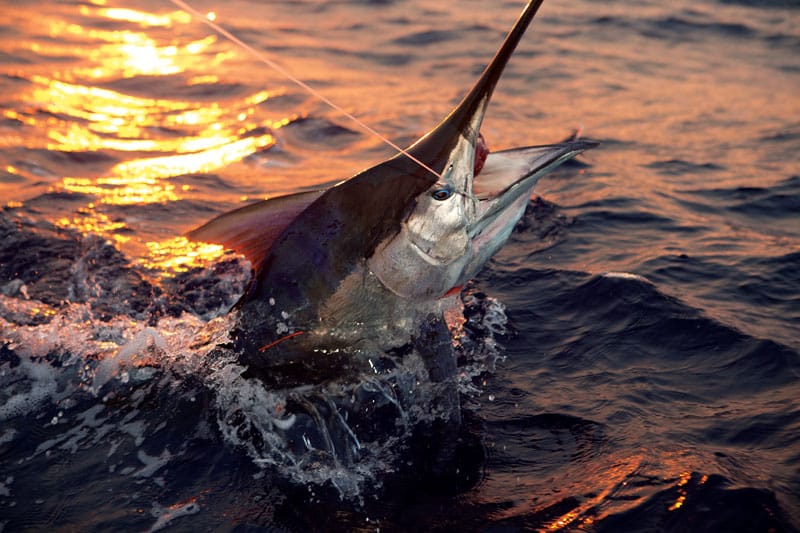
Any blue-water angler worth his salt would be excited after viewing a chart of the Tuna Coast. This 70-mile Pacific shoreline at the southern end of the massive Azuero Peninsula separates the Gulf of Panama from the Gulf of Chiriqui. It’s so close to the 100-fathom line that anglers have taken sailfish, dorado and yellowfin tuna within casting distance of its rocky shoreline. The meandering continental shelf is only a half-mile offshore in many places, with the widest point only 4 miles at its easterly end.
One of the constraints to developing this marlin fishery is that the boat of choice has long been the single outboard panga with its narrow beam, limited range and a lack of fishing amenities, like tuna tubes, that we have come to expect on a marlin pursuit.
A few exceptions are available now, such as the Cebaco Bay Sportfishing Club, Pedasi Jeff Charters and Panafishing Adventure, with larger boats to choose from. Most of the panga fleet is found near the town of Pedasi on the eastern side of Panama, while -scattered charters are available as far west as Cambutal, where the coast becomes remote and nearly unfished, to its westerly end at Punta Mariato. In between, numerous rocky islets, high spots, and reefs attract bait and billfish.
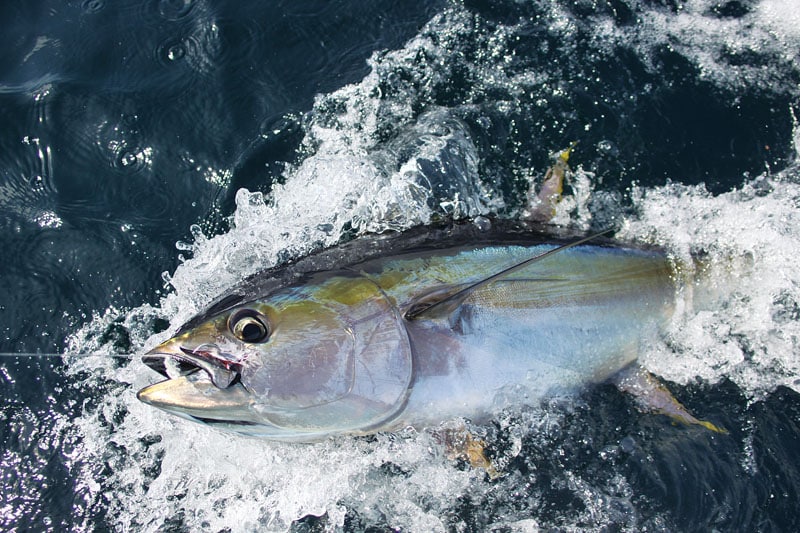
Marlin Hangouts
Black marlin can pop up just about anywhere and have surprised many inshore anglers in pursuit of smaller game. However, good structure that consistently harbors baitfish is a favored habitat. This includes the twists and turns of the continental shelf that help create upwellings and nutrients farther offshore along the freighter lanes. From east to west along the Tuna Coast, you’ll find many opportunities for a marlin encounter.
Fast blind-trolling in transit along the freighter lanes 6 to 10 miles offshore is generally not productive unless concentrations of spotted, spinner or common dolphin with birds and bait are present. This is the opportunity to pursue blue and black marlin, larger yellowfin tuna exceeding 100 pounds, and other pelagics such as dorado and sailfish. Even the panga fleet works offshore, especially when the nearshore grounds are not productive. Just be cautious of strong north winds that prevail from January to May along the easterly coast.
Rigging live bait such as the -common black skipjack on the spot will work without bait tank or tubes, but it adds to the challenge of small-boat fishing. School tuna are common near the surface and provide good popping action, while the large fish tend to stay deeper and might be boat shy due to the -pressure of commercial tuna boats. Using downriggers or Zwings not only can improve your catch rate with tuna, but with marlin as well.
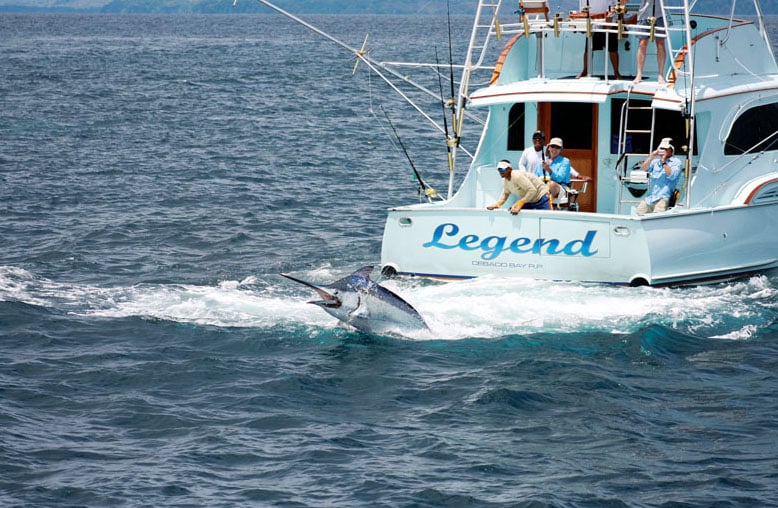
Isla Iguana
Famous for its wahoo fishery, Isla Iguana is a 58-hectare wildlife refuge located just 2 miles off Punta del Tigre. Richard Castaneda, owner of Cass Tours, started taking groups of U.S. anglers to the Tuna Coast shortly after I introduced him to the area in June 2000. Since then, many of his clients have recorded smaller black marlin of 200 to 300 pounds when fishing for wahoo close to this small island, especially when the yellowfin and skipjack schools congregate off its eastern shoreline. It continues to be worth a look since it is close to the panga fleet, but it’s not considered a primary go-to spot for marlin.
Media Luna
Nine miles northeast of Iguana is Media Luna, which is one of the key offshore spots for black marlin according to Capt. Jeff Hopkins, who operates a 29-foot Phoenix and has been fishing here since 1998. “We’ll usually start our trolling or live-baiting from this bajo, especially if the north winds are active. That way, we can hit all the deeper-water areas with following seas,” says Hopkins.
Six miles northeast of Punta Mala, La Bruja is in 150 feet depth, and is popular with the pangeros due to its short -distance and good bottomfishing. Twelve miles southeast of Punta Mala, La Bruja marks the eastern corner of the Tuna Coast. Strong currents combined with wind here can make for a -challenging, if not dangerous, sea -conditions, especially from January to May. Pargo Grande is a 175-foot-high spot popular with the commercial -snapper fleet, and it also attracts black marlin. Again, bait and blue water are signs to look for before devoting prime fishing time here. Hand-line panga fishermen prefer small snapper for the restaurant trade, but I know of at least one who caught an 850-pound black marlin with this method. Unfortunately, releasing marlin is not a common ethic among the commercial guys.
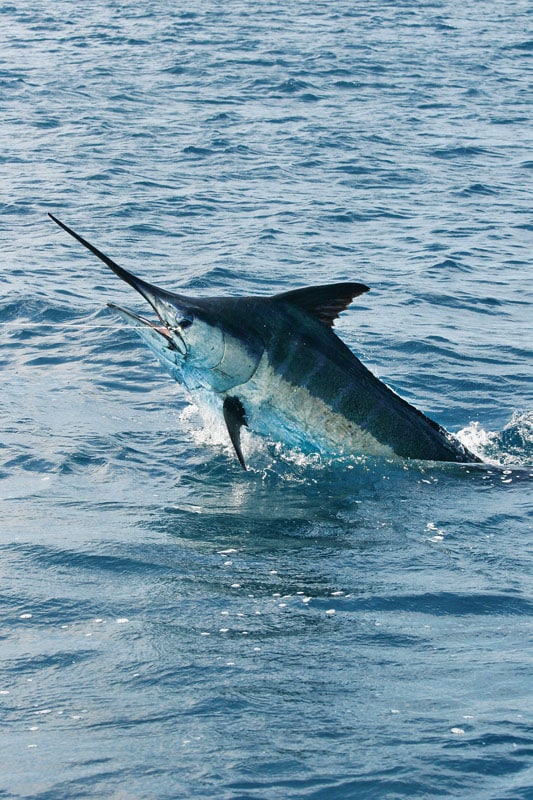
Volcan
This sharp peak appears as a volcano on a graph and is 24 miles southeast of Punta Mala. Blue marlin, as well as black marlin and larger yellowfin tuna, are more likely to be found here due to the surrounding water depth.
Frailes Del Sur
This rocky, weather-beaten island, with its white lighthouse towering above, is a major landmark and fishing destination. It lies in 253 feet, but within a half-mile, the depth drops to 1,880 feet. It is on the boundary between the nearshore and offshore fisheries, and a great mix of species can be found here. The Achotines Laboratory or Tuna Lab, part of the Inter-American Tropical Tuna Commission’s Tuna-Billfish Program, is located directly onshore 5 miles north of Los Frailes. Lab collectors routinely catch yellowfin tuna near the island, and deliver live specimens to the lab for new stock.
Los Frailes is a top spot for black marlin because they often come in close to the rocks to feed on black skipjack, yellowfin tuna, bonito and bottomfish. Capt. Jim Wiese has released many black marlin here, taking time from his transits between Cebaco Bay and Panama City. “I’ll stop here any time the water is blue with lots of bait,” Wiese says. “In September 2010, we hooked a 400-pound marlin and had it greyhounding through a fleet of pangas loaded with tourists. After a release and the usual celebrations we go through, we heard clapping and cheering from the small boats, as they had front-row seats to a marlin show. It doesn’t get much better than that and made me even more enthusiastic about this spot.”
Most of the panga skippers have no live-bait systems on board and rarely catch live bait unless clients insist. Otherwise, popping and jigging for light-tackle species is the focus. Conditions here can change quickly, with 17-plus-foot tides creating a fast-moving current. Dirty water shuts down the fishery until calm blue seas and baitfish return, sometimes within a few hours, as the prevailing oceanic currents swing closer to the mainland. Timing a trip during a moderate-tide period is a good idea.
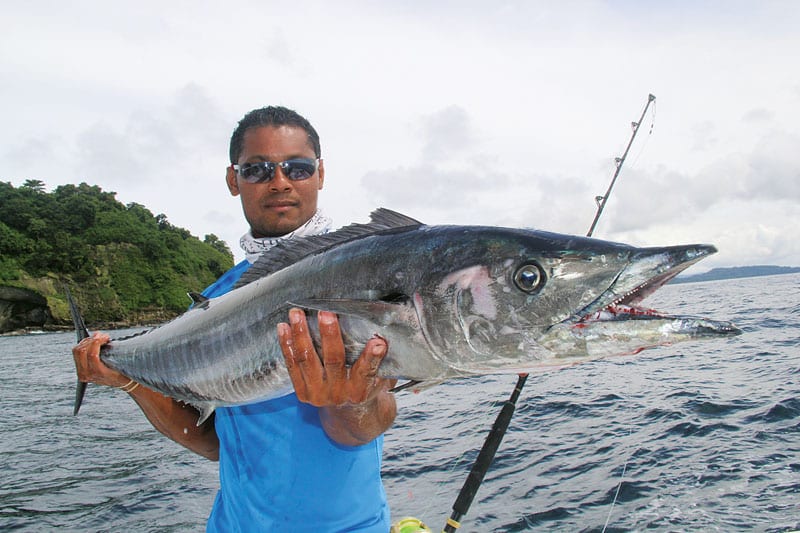
Morro De Puercos
Morro de Puercos is a cluster of high spots 4 miles southeast of Punta Morro de Puercos, which marks the halfway point along the Tuna Coast. From here to the westerly end, the Cerro de Hoya mountain range rises steeply along the coast, providing a lee with prevailing calm seas and blue-water conditions. The 100-fathom line swings in within a few miles of shore, providing an easy pelagic gateway to the feeding grounds.
According to Wiese: “Schools of bait tend to concentrate on the flats here that rise gently from 600 feet to 300 feet. Our boats from Cebaco fish Morro Puerco every chance they get. Most yachts in transit fish too far offshore, not aware that this coast is like Kona, Hawaii, where extremely deep water is close to shore. Just remember: Blue water is a must to get a black marlin bite going.”
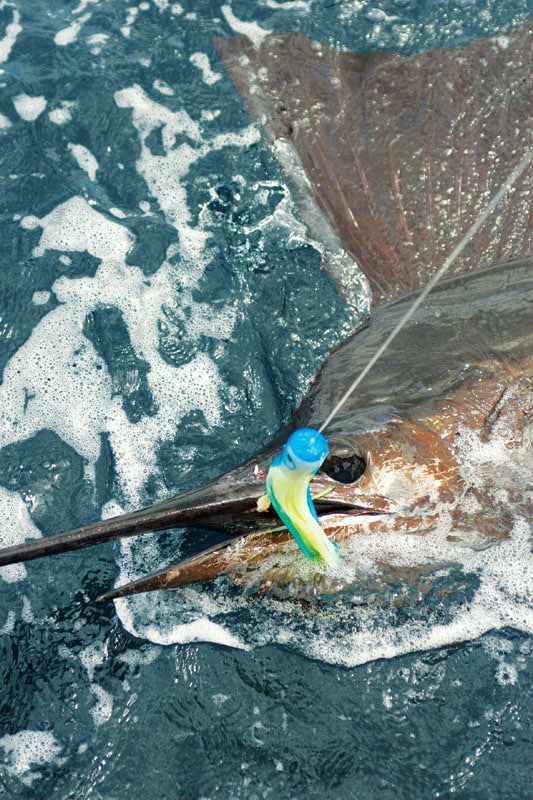
Punta Mariato
Marked by an automated navigation light tower on its jungle cliffs above a scenic rocky headland, Punta Mariato is the main attraction of a truly unspoiled, remote habitat where you might not see another sport boat for a week or more. A few artisanal single-outboard craft and cayucas, or dugout canoes, are used by the local indigenous families for subsistence fishing. It is here that they get an unusual mix of pelagics and inshore game fish such as tuna and snapper at the same spot. “Just off this point is an awesome marlin hole that regularly -produces black marlin,” says Wiese. “There is a small reef located less than a half-mile from shore that rises to 120 feet from 1,500 feet over a distance of less than 2 miles. I have yet to take a marlin from here, but if I were to pick the best one hour of casting and butterfly jigging I’ve ever had, it came from this spot. A 45-pound -amberjack, 70-pound cubera snapper and a 50-pound roosterfish fell for my OTI Wombat Popper and Shimano Butterfly back to back.”
Islote Roncador
Shaped like the Rock of Gibraltar, Roncador is clearly visible at low tide and large swell. It can be a hazard to navigation when covered up but still subject to breaking swells. A favorite wahoo and cubera spot, Roncador is also a great spot for both black marlin and sailfish. The huge centerpiece rock spreads out into a jagged bottom structure -providing plenty of cover for baitfish such as cojinua (green jack) and skipjack. Slow-trolling live bait close to the rock and up to a half-mile off is a good strategy for a marlin hookup when not interrupted by huge cubera and roosterfish.
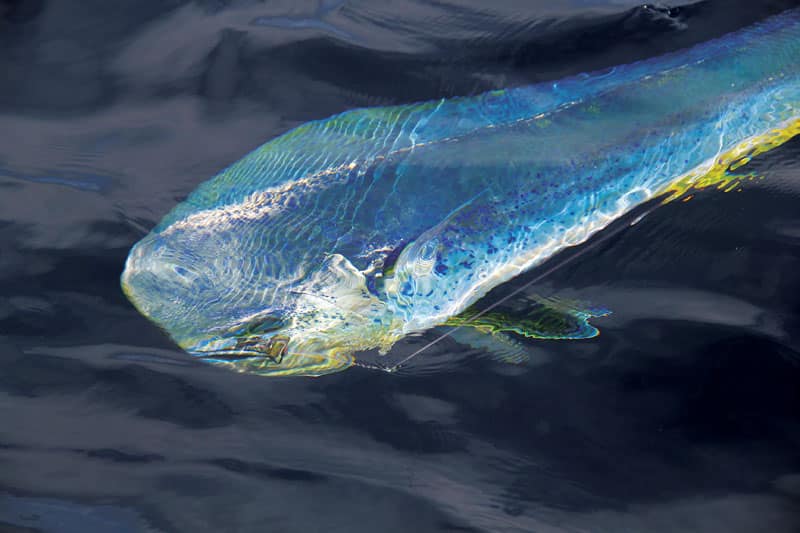
Aguja Reef
Five miles due west of Roncador is Aguja Reef, which marks the end of the Tuna Coast marlin chain. Barely larger than a football field, more marlin are caught here than any other spot on the Tuna Coast. At times, it’s off the charts, with as many as 10 black marlin released in one day by Wiese’s crew. During one three-month period, oceanic skipjack replaced the normal black skipjack as the primary forage. Multiple hookups were common, rivaling both Piñas Bay and Hannibal Bank for productivity. Again, good -current, blue water and -plentiful baitfish are the key. On Omega Chart 21580, it is marked as a circled 59 feet, but the highest point recorded is 135 feet at low tide (tides can exceed 17 feet on Panama’s Pacific Coast).
Bring Your Poppers and Jigs
Even hard-core billfish anglers get a thrill out of popping and deep–jigging along the very same Tuna Coast hangouts that attract marlin. The untouched western portion of the coast all the way to Cebaco Island is a world-class inshore fishery. Panama is famous for its aggressive, competitive game fish that can destroy your popper or rock you with a buttoned-down drag. Last July, we fished two anglers on a Cebaco 31-foot Bertram and, in six days of inshore fishing, recorded 30 -species of fish out of 238 landed, with 231 released — keeping a few for gourmet meals on board the ship.
These included cubera snapper, roosterfish, amberjack, African pompano, wahoo, bluefin trevally, bigeye trevally, jack crevalle, barracuda, dorado, yellowfin tuna, mullet -snapper and rainbow runner. All roosterfish, cubera and bluefin trevally are released, in keeping with a recommended policy of the Panama Marine Resource Foundation. We lost several trophy fish to the bottom structure, even though they were hooked on the surface; a 45-pound drag setting couldn’t stop them from reaching the bottom, sometimes in 80 feet or more of water. Now that will keep you coming back.
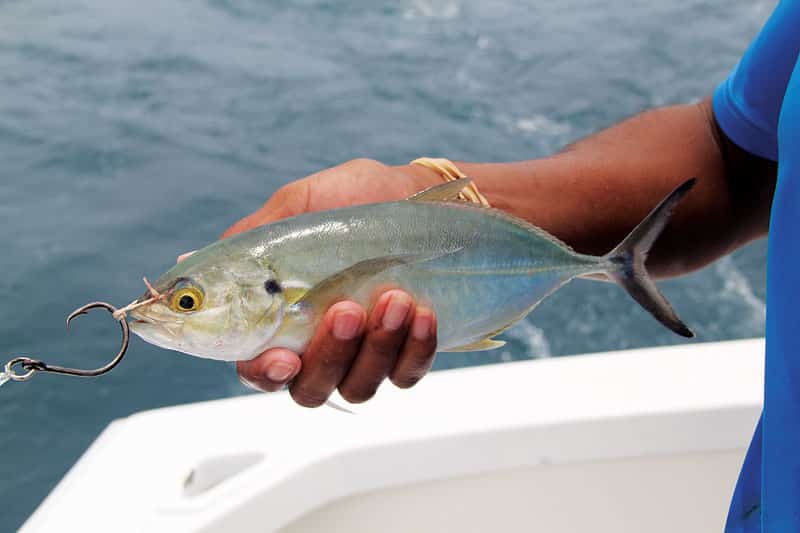
Going to the Tuna Coast
The Republic of Panama is served by daily, nonstop flights from Los Angeles, Houston, Newark, New Jersey, Miami and other cities. After arriving in Panama City, most anglers will overnight before taking a ground transfer of four hours to Cebaco or five hours to Pedasi. The popular “fisherman’s hotel” is the Wyndham Grand Veneto Hotel and Casino; others include the Trump Tower, Marriott, Miramar Intercontinental and Sheraton. A growing number of anglers are taking a half-day to fish peacock bass and occasional snook and tarpon in nearby Gatun Lake, part of the Panama Canal. Starlite Travel (starlite@cwpanama.net) can arrange for this excursion as well as hotels, transfers and tours.
The Cebaco Bay Sportfishing Club‘s fleet now includes two fully air-conditioned motherships, including the 110-foot Cebaco Bay that accommodates nine anglers, and the 115-foot Discovery that handles 16 guests in eight double-occupancy staterooms with Sky TV, full bar and gourmet-food service. The fishing is done from five 31-foot Bertrams and two 27-foot Caribe Pro center consoles. Contact: Ms. Dee Salvas; 228-861-0418 (U.S.); [email protected]; Carmen Cordova; 507-6679-8083; [email protected].
Capt. Jeff Hopkins offers a 26-foot twin-outboard -center console and a 29-foot twin-diesel Phoenix flybridge. Contact: 507-995-2149; [email protected].
Capt. Tom Gibbs provides accommodations and can book pangas. Contact: 507-995-2894; [email protected]; pedasisportsclub.com.
Panafishing Adventure has two 26-foot Power Cat Twin Vees and two 25-foot Caribe Pro pangas; Accommodations include AC and a pool. Contact: 507-6498-1593; [email protected]; panafishing.com.
Capt. Tony Herndon; 28-foot center-console panga. Contact: 507-6622-0212; captaintony@panamafishingandcatching.com.
Capt. Augusto Lopez has a small bed-and-breakfast overlooking Playa Ciruelo and 25-foot center-console SeaCraft. Contact: 507-6671-9421; [email protected].
Cass Tours hosts groups from the United States. Contact: 800-593-6510; [email protected]; casstours.com.
Villa Marina at Playa Venao can arrange for charters to pick up anglers from its calm beach. Contact: 507‑832-5044; reservaciones@villamarinapanama.com.
